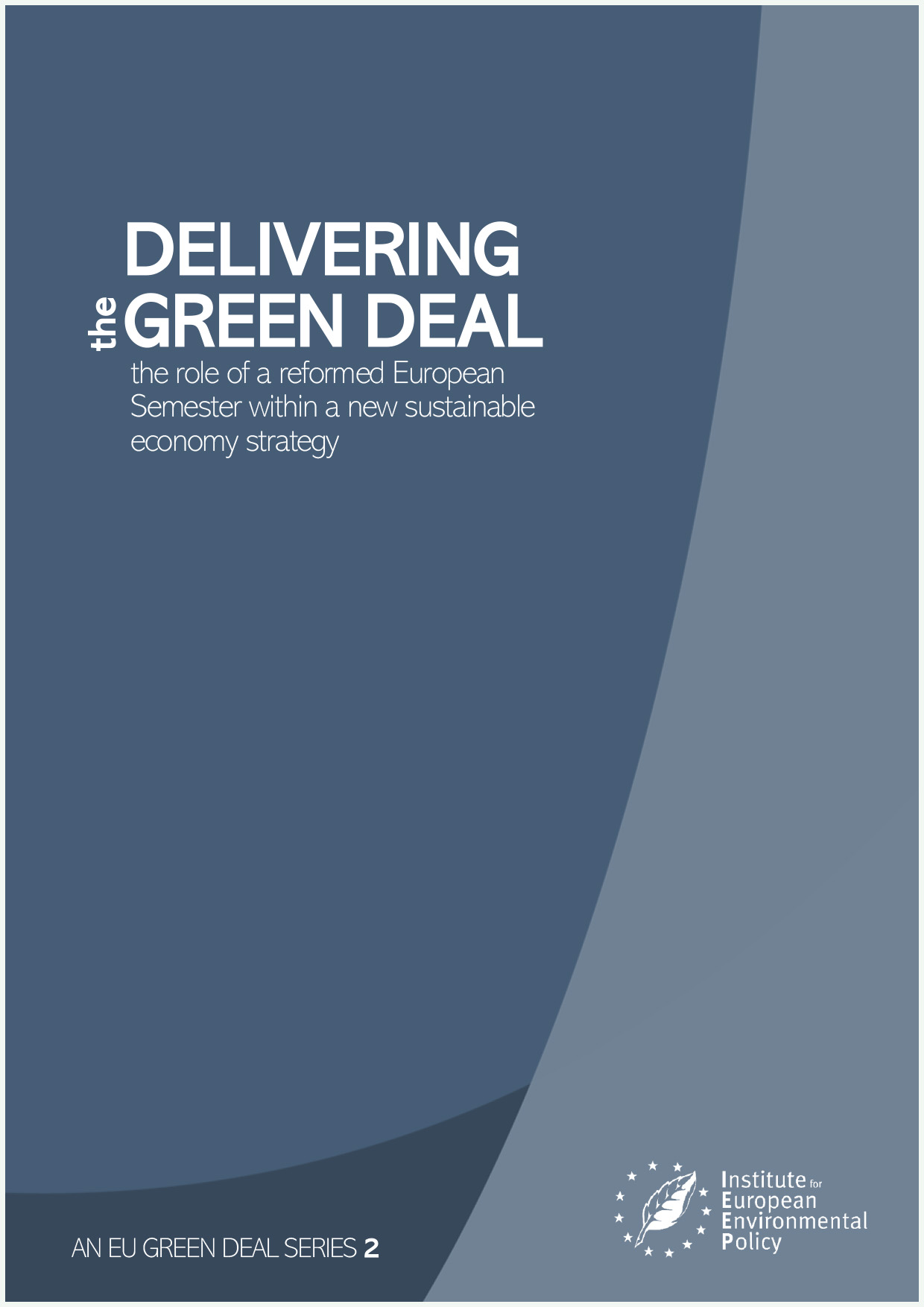AUTHOR: Céline Charveriat
Does the European Semester Spring Package of recommendations manage to move beyond GDP and push the sustainability agenda forward?
Last week, China’s National People Congress abandoned setting a gross domestic product target for the first time in its history.
While less dramatic and less noticed, the newly published European Semester Spring Package seems to confirm a shift away from the mantra of growth within the European Commission. Of course, Europe has never had a growth target per se, but the vision of the EU’s previous Commission, enshrined in the 2020 agenda, was “jobs and growth”.
In contrast, the so-called Country Specific Recommendations (CSRs) in the Spring Package explicitly highlight the “interconnectedness of economic, social and environmental spheres and the need for a holistic approach to recovery”.
The concept of “competitive sustainability”, with its four dimensions of economic stability, social fairness, environmental sustainability and productivity and competitiveness, is also presented as “the heart of Europe’s social market economy” and a key lever to “achieve the United Nations Sustainable Development Goals and be on track for climate neutrality in 2050”.
 IEEP’s paper outlines eight dimensions for monitoring sustainability in the European Semester IEEP’s paper outlines eight dimensions for monitoring sustainability in the European Semester |
In a recently published paper, IEEP proposed the integration of a sustainability scoreboard within the semester that would monitor progress on eight key dimensions, many of which start to be addressed in the spring package:
1. The role of public finance
The European Commission states that “current conditions permit the activation of the general escape clause, allowing the Member States to depart from the budgetary requirements that would normally apply while enabling the Commission and the Council to undertake the necessary policy coordination measures within the framework of the Pact.” Recommendations also highlight the importance of prioritising investment and productive expenditure within recovery strategies.
2. Promotion of the green economy
A call to a green recovery is present in all countries’ recommendations. The following sectors are highlighted: renewable energy, energy efficiency, sustainable transport (including public transport, alternative to cars, etc.).
 |
3. The long-term sustainability of the economy…
…is partially covered. There is still no reference to the need to preserve Europe’s natural capital, including fresh air and water, soil and forestry. However, challenges linked with the quality and scarcity of water are mentioned in the case of Spain, Romania, Slovakia, Portugal, Hungary. Forest fires are addressed in the case of Italy.
| There is a much greater understanding of the importance of health for the economy |
While the key to sustainability but also to rural employment in several countries of the Union, agriculture is only mentioned twice (in the case of Hungary and Latvia). On a more positive note, because of the pandemic, there is a much greater understanding of the importance of health for the economy.
Air pollution is mentioned for several countries (Spain, Slovenia, Romania, Slovakia, Poland, Italy, Hungary), however, recommendations fall short of considering investments into a green and just care economy as a key sector for investment as part of the recovery and the strengthening of resilience against future shocks.
4. Green incentives, taxes and subsidies…
…are explicitly mentioned in the recommendations for Austria: “Tax reforms could help to shift the tax mix towards sources that are less detrimental to inclusive and sustainable growth and provide a solid basis for recovery. In particular, insufficiently-used taxes on alcohol and tobacco, pollution and resource consumption imply unused steering effects and revenue potential.”
| No specific reference is made to the use of state aid or the recourse to environmentally harmful subsidies |
While the risk of distortions to convergence and the single market are identified, no specific reference is made to the use of state aid or the recourse to environmentally harmful subsidies and their potential distortive impact on competition.
5. Green R&D and innovation
The role of green research, development and innovation as a key lever to implement national energy and climate plans (NECPs) and achieve carbon neutrality is addressed in all the recommendations.
In the case of Germany, the role of R&D is highlighted in the following way: “Additional investment in research and development (R&D) is essential to foster a recovery towards a more sustainable and competitive economy. Spending on education and research remained at 9,1% of GDP in 2018, falling short of the national target of 10%.”
 |
6. Sustainable industry
Recommendations cover several elements related to the phase-out of the brown economy, with recommendations regarding coal and carbon-intensive sectors for Slovakia, Romania and Poland.
| The just transition is addressed in-depth through a specific annex with guidance on investment |
It is highly welcome that the just transition is addressed in-depth, including through a specific annex with guidance on investment for the transition. In the case of Bulgaria, the Commission states the need to focus on the Maritsa industrial complex in the Stara Zagora province and to anticipate social challenges, such as job losses and lowering of life quality standards, through several concrete proposals including upskilling and reskilling of workers; job-search assistance to jobseekers; active inclusion of jobseekers and well as a productive investment into SMEs.
Recommendations regarding the circular economy are less convincing as they remain generic and mostly focus on waste and recycling. Oddly, the steel, chemical sectors and mobility supply chains are singled out as “strategic supply chains for resilience, sustainability and strategic autonomy” without any qualifier regarding the unsustainability of these sectors or assessment of the environmental impacts linked with relocalisation.
| Little consideration is given to potential dilemmas between sustainability and digitalisation |
While digitalisation is mentioned in all reports as a twin to the sustainability transition, little consideration is given to potential dilemmas between sustainability and digitalisation.
7. The systemic nature of climate change risk for the economy…
…is not addressed overall. However, it is alluded to in the recommendations towards Italy, with references to the need for greater adaptation and resilience, including for its health infrastructure.
8. Negative and positive external spillover effects of Europe’s strategy for recovery…
…are not addressed in the document, in contradiction with the agenda of the SDGs, which is universal.
| For more on spillovers, see 2019 Europe Sustainable Development Report |
 Word cloud analysis using the European Semester country-specific recommendations for Austria, Belgium, France, Hungary, Ireland, Italy, the Netherlands, Poland, Slovakia, Slovenia, Spain, and Sweden Word cloud analysis using the European Semester country-specific recommendations for Austria, Belgium, France, Hungary, Ireland, Italy, the Netherlands, Poland, Slovakia, Slovenia, Spain, and Sweden |
As demonstrated by the word cloud above, while Europe’s attachment to GDP is not yet dead, the coronavirus might have done more to move Europe’s towards a more holistic notion of sustainable prosperity than the ten thousands of pages and the multiple conferences dedicated to “Beyond GDP”.
Let’s hope that this shift away from GDP survives longer than the virus and opens a new chapter in fulfilling Europe’s vision of “living well, within planetary boundaries”, as stated in the 7th Environment Action Programme. Another important signal is the publication of the new budget proposal for the European Union. Will the next MFF pass the test of sustainability?
Céline Charveriat is the Executive Director of IEEP
